While turnkey Raman systems can be convenient and powerful, they often are optimized for a specific application or sample type. Modular Raman systems are less restrictive, enabling the user to configure a system for a unique application or excitation wavelength. Components can be optimized as needs evolve; they also can be used in other applications, increasing overall value and flexibility. Many of our OEMs working with Raman spectroscopy begin with a modular Raman system.
We’ll discuss the factors to consider in choosing each component of a modular Raman spectroscopy system. With multiple spectrometer, laser, probe and software options, Ocean Optics has mix-and-match solutions to suit a wide variety of needs.
Modular Raman Spectroscopy
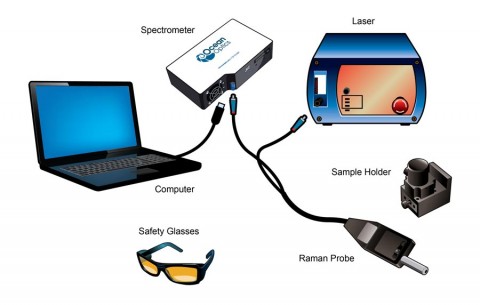 Generation of a Raman spectrum begins with an excitation laser, typically routed to the sample with a specialized Raman probe (free-space coupling is also possible). Scattered Raman light is collected by the same probe and routed to a spectrometer that is configured with the sensitivity, optical resolution and Raman shift range needed for your application. We even offer sample holders to facilitate measurement of liquids in cuvettes and vials.
Generation of a Raman spectrum begins with an excitation laser, typically routed to the sample with a specialized Raman probe (free-space coupling is also possible). Scattered Raman light is collected by the same probe and routed to a spectrometer that is configured with the sensitivity, optical resolution and Raman shift range needed for your application. We even offer sample holders to facilitate measurement of liquids in cuvettes and vials.
Modular Spectrometers
Ocean Optics offers several spectrometer benches for Raman spectroscopy, each with its own strengths to balance sensitivity and signal to noise with resolution.
Maya2000 Pro
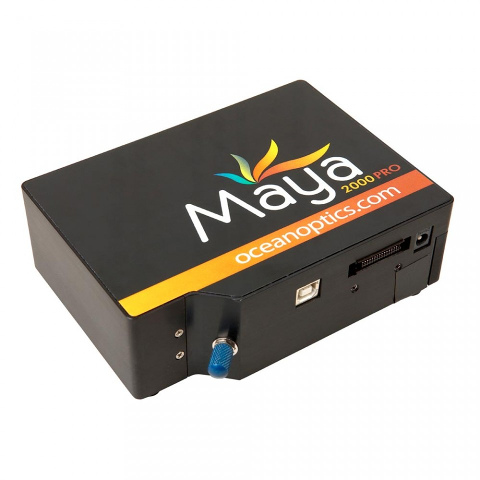
The Maya2000 Pro is a good general purpose configurable spectrometer for Raman, combining a low stray light optical design with an uncooled back-thinned FFT-CCD detector for enhanced sensitivity that is value-priced. High quantum efficiency in the NIR makes it an excellent choice for long-wavelength Raman.
QE Pro
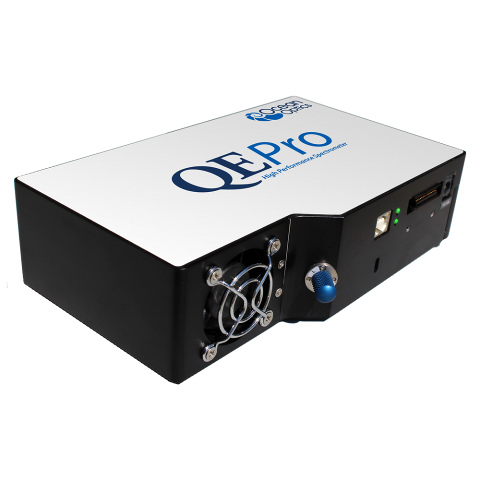
This premium quality configurable spectrometer yields the highest quality Raman spectra, both in resolution and signal to noise. Designed with gold-coated mirrors and a back-thinned FFT-CCD detector cooled to -15 °C, the QE Pro offers a low noise floor even at long integration times. Its ability to deliver sharp peaks from very weak Raman signals makes it an excellent choice when your exact application needs are undefined. The QE Pro also features interchangeable slits, allowing resolution to be adjusted quickly and easily for system optimization and use in other applications such as fluorescence or high-resolution spectroscopy. An optional internal shutter also simplifies acquisition of dark spectra.
Ventana Series
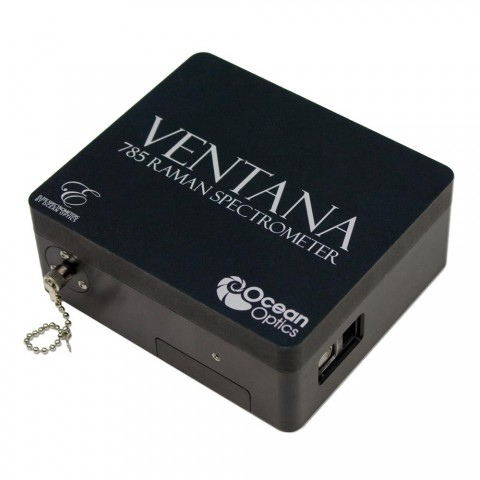
The Ventana series of preconfigured spectrometers are designed specifically for Raman spectroscopy. By using a volume phase grating and a lower f/# than our other spectrometers (f/1.3 vs. f/4), they deliver higher throughput for fast measurements. This is further enhanced by control of the detector temperature at +15 °C, keeping the noise floor consistent for applications at short integration times.
NIRQuest

This compact NIR spectrometer delivers high quality spectra with 10,000:1 signal to noise by using a thermoelectrically cooled InGaAs detector and a similar optical bench design to the QE Pro. Available with a 256 or 512 pixel detector, NIRQuest can be configured for 1064 nm Raman or custom wavelength, range and resolution needs. It features interchangeable slits for dynamic resolution adjustments, and is offered with an optional internal shutter for rapid acquisition of dark spectra
Spectrometers: Resolution vs. Range
The application in question will determine the range and resolution needed of the Raman spectroscopy system. Discrimination of natural diamond from simulants involves the presence or absence of a single peak at 1332 cm-1, and graphene characterization just a few peaks from 1350 cm-1 to 2700 cm-1. Raman spectra of pharmaceuticals and other organic compounds, however, have rich fingerprints that can begin shortly after the laser wavelength and extend to beyond 3000 cm-1.
Moderate spectrometer resolution (8-12 cm-1) is adequate for many fingerprinting applications like identifying or discriminating between materials. Higher resolution is needed to see structural changes, as in crystals and protein folding, or to look at stress or hydrogen bonding effects.
It is important to note that resolution of a Raman spectrometer in cm-1 also depends on the excitation wavelength, as Raman shift is measured relative to the laser wavelength in wavenumber space (cm-1, the inverse of wavelength). For a Raman peak at 1000 cm-1, a spectrometer with 0.4 nm resolution would yield ~5.5 cm-1 resolution using 785 nm excitation, ~8.5 cm-1 resolution using 638 nm excitation, and ~12.5 cm-1 resolution using 532 nm excitation. For the same reason, systems configured for longer wavelength excitation also cover less range in cm-1.
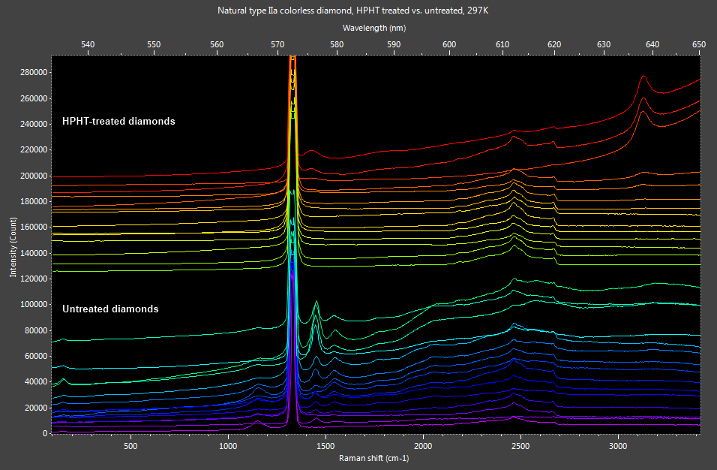
Raman spectra of HPHT (high-pressure, high-temperature) treated diamonds and untreated diamonds using 532 nm excitation. Spectrometer detection wavelength in nm is on the top x-axis, and Raman shift in cm-1 is on the bottom x-axis. (Image courtesy of Foral Design Ltd., www.gemmoraman.com)
Spectrometers: Sensitivity vs. Speed
The noise inherent in a Raman spectroscopy system, particularly relative to the signal level obtained, is one of the largest factors impacting data quality and ability to resolve peaks. Cooling of the detector can reduce noise significantly, particularly when looking for weak Raman signals.
Measurement of baseline noise at 200 ms and 5000 ms integration time for the 785 nm preconfigured version of each of our modular Raman spectrometers quickly demonstrates the differences in temperature control of the respective detectors and how they affect noise.
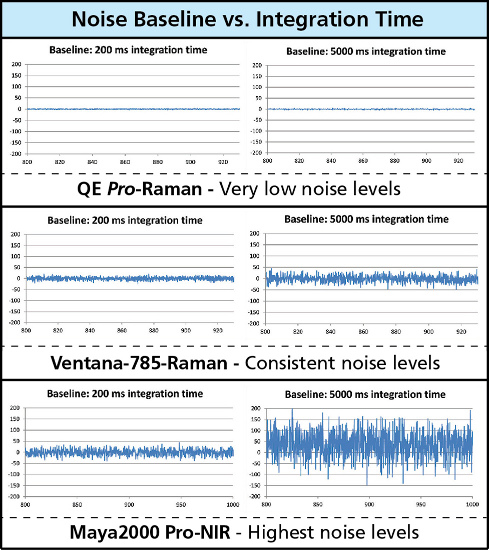
The QE Pro detector is TEC cooled to -15 °C, offering very low noise levels, even at long integration times. The detector used in the Ventana is not cooled, but is temperature stabilized to +15 °C. Although noise is higher at short integration times, it is consistent from one measurement to the next, making this system good for fast measurements, but unsuitable for long integration times. The more cost-efficient Maya2000 spectrometer has no temperature control, exhibiting the highest noise levels.
We can see even more clearly the overall sensitivity and S:N ratio of each spectrometer by comparing spectra of toluene acquired at low laser power. The Ventana yields a good quality spectrum in just 23 ms, demonstrating its utility for fast measurements. The Maya2000 Pro-NIR yields a reasonable spectrum at 168 ms – noisier, but adequate for many stronger Raman signals at a lower price point. It is the QE Pro-Raman, however, that truly shines, with a very clean, low-noise spectrum at a much longer 525 ms, firmly placing it as the spectrometer of choice for long integration time measurement of weak Raman signals.

Lasers: Optimizing Excitation
The intensity of Raman scattered light is proportional to 1/λ4, where λ is the excitation wavelength. This means that shorter excitation wavelengths will generate a stronger Raman signal. Despite this, 785 nm remains the most common wavelength used for Raman spectroscopy, primarily due to autofluorescence. Many samples, particularly those organic in nature, tend to autofluoresce when exposed to visible laser light. Appearing as a broad background that tends to fall off at longer Raman shifts, autofluorescence signal can overwhelm the Raman spectrum, or at the very least degrade signal to noise and make Raman peaks difficult to resolve.
Organic samples are best studied using red or NIR excitation wavelengths (660-830 nm), where the significant reduction in autofluorescence background balances out the reduction in signal in terms of signal to noise. Autofluorescence is of far less concern for inorganic materials, including carbon nanotubes and fullerenes, in which case shorter excitation wavelengths like 532 nm are typically used.
It is possible to avoid autofluorescence entirely, but at a cost. Excitation at 1064 nm virtually eliminates autofluorescence, but also reduces the strength of the Raman signal significantly. Reduced sensitivity is often a concern when working with NIR detectors, but since this is balanced by the reduction in background, S:N ratio overall remains reasonable at NIR wavelengths. The greater deterrent for NIR Raman spectroscopy is cost, as NIR spectrometers are significantly more expensive than their silicon-based counterparts in the visible region.
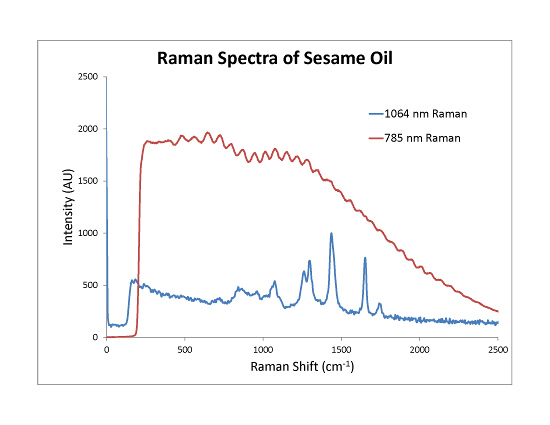
The Raman spectrum of sesame oil shows much lower autofluorescence background when excited by a 1064 nm laser than when a 785 nm laser is used.
The other option is to move below the autofluorescence window entirely, into the ultraviolet. UV excitation is tempting because the full Raman fingerprint region (500-2000 cm-1) can be collected prior to the onset of autofluorescence at ~330 nm. So why isn’t this done more often? Here, technical limitations prevail – UV lasers and filters are more expensive and offer lower performance, while the high energy of UV light can damage samples quickly during measurement. Spectrometer resolution also becomes a factor, as achieving 10 cm-1 resolution using a 785 nm excitation laser at a Raman shift of 400 cm-1 requires a 0.66 nm resolution spectrometer, while with a 248 nm excitation laser, a much lower spectrometer resolution of 0.06 nm is needed.
Probes: Flexible Sampling
Fiber-coupled probes are a very convenient and flexible method of interfacing with a sample to collect Raman spectra, as they can be used for solids, surfaces, liquids or powders. Our Raman probes are designed for optimum signal collection, with highly blocking integrated filters at the tip to remove autofluorescence from the excitation path fiber, and Rayleigh scatter of laser light from the sample.
These probes are designed with a 1-10 mm working distance, depending on the model, allowing spectra to be collected upon direct immersion in process mixtures, or non-invasively through vials and bags. Probes include designs for general purpose, immersion and process use. A manual safety shutter has been incorporated in the general purpose probes for eye safety, though laser safety glasses are always recommended.
Software: Libraries and More
OceanView software offers a Raman experiment mode, in which the excitation laser wavelength can be input for direct viewing and export of spectra in wavenumbers (cm-1). We also offer software from Analyze IQ, including powerful chemometric analysis for spectral matching, spectral analysis tools, spectral database management, and spectral libraries containing nearly 1,900 compounds.
Preconfigured Modular Systems: Convenient Bundles
Ready to get started, but still a nervous about configuring your modular Raman spectroscopy system? We’ve preconfigured some for you, from 532 to 1064 nm, and thrown in some additional savings for a limited time. Designed to operate as a system, the components in these bundles mate seamlessly to get you started taking Raman spectra more quickly. All bundles come with OceanView software and the appropriate laser safety glasses.
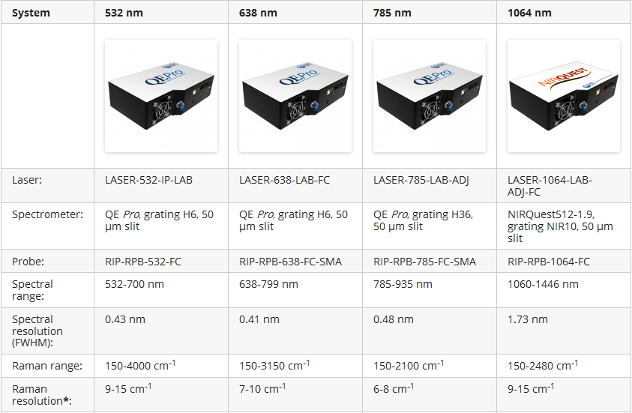
Conclusion
The design of your modular Raman spectroscopy system will be guided by the application, including factors like the sample under study and needs for sensitivity or speed of measurement. With multiple spectrometer bench options, excitation lasers from 532 to 1064 nm, probes and sampling accessories, we have the options and technical support to get you started today. Contact us to begin discussing your needs with an Applications Scientist today.
Download the 12-page Raman Spectroscopy Catalog Now!












































